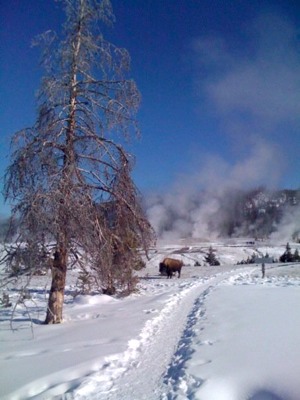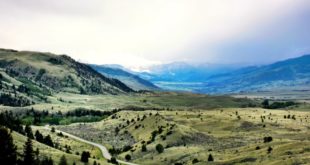The National Park Service is currently seeking public comment on what should be included in the next Winter Use Plan and Environmental Impact Statement (EIS) for Yellowstone National Park. This long-term plan will guide the management of winter use in the park to ensure that park visitors have a range of appropriate winter opportunities, that these activities are in a suitable setting, and that they do not impair or irreparably harm park resources or values.
Scoping is an opportunity early in the planning and EIS process for the public, organizations, and other agencies to suggest issues and alternatives that should be considered by the NPS in preparing the plan and EIS.
The EIS will consider a variety of alternatives for managing winter use in the park, including: the use of snowmobiles, snowcoaches, and wheeled vehicles; and guiding requirements. The EIS will evaluate the environmental effects of winter use on air quality and visibility, wildlife, natural soundscapes, employee and visitor health and safety, visitor experience, and socioeconomics.
NPS officials have held meetings in Yellowstone-region communities to discuss what should be included — and excluded — when discussing the winter use of Yellowstone. One thing is very clear from the public comments: fans want more access to Yellowstone National Park in the wintertime. Here are some of the idea.
Instead of grooming roads, plow them and open them to car traffic. This is the idea that’s gaining the most steam among Yellowstone National Park enthusiasts. Right now the only section of Yellowstone National Park open to car traffic year-round is the stretch between the North Entrance at Gardiner and Cooke City; the entire section of road is plowed by the National Park Service. The Lamar Valley has emerged as a tourist attraction in winter months, with visitor numbers gaining steadily annually.
The idea pushed by a West Yellowstone group would have the Park Service plow the road between that city and the Old Faithful area. They argue it would be a money-saving move (it costs more to groom than plow, they say), and it would drastically increase access to Old Faithful during one of the most beautiful times of year. It currently is expensive to see Old Faithful in the winter season: the minimum price for a Xanterra snowcoach round-trip ride is over $110, with a snowmobile costing more. You could argue the average person is priced out of a Yellowstone winter visit.
The problem, according to animal-advocacy groups: there’s enough stress on Yellowstone animals from snowmobiles, never mind increasing it with cars. That is an issue: animals tend to use roads more in the winter than in the summer because it’s more convenient. That’s one of the reasons why a winter visit to Yellowstone is so exciting now: you get plenty of easy access for critter-watching. Throw cars in the mix and you change the equilibrium that currently exists.
Some groups are also arguing for the plowing of Hwy. 212 between Cooke City and Wyoming Hwy. 296, the Chief Joseph Highway/Sunlight Basin Road. This road is plowed by Wyoming, but since the eight-mile stretch between Cooke City and the 296 intersection is not plowed, there’s no easy access to the Park from the northeast. Eight miles doesn’t seem like a huge stretch to plow — it’s currently groomed and popular among snowmobilers — but before road improvements in the last several years there were some treacherous stretches of road within those eight miles. With the road improved, plowing may be more feasible — and it could end up breathing some new life into Cooke City and Cody tourism.
As long as they’re plowing, why not go all the way down to Grand Teton?
Screw the cars; open more snowmobile access. Snowmobile enthusiasts don’t want to see cars supplanting their access routes; they’d rather see the Yellowstone roads limited to snowmobiles.
More of them, as a matter of fact. Advocates are arguing that experienced snowmobilers should be allowed within the Park without a guide. Again, cost is an issue; without the need to hire a guide, more folks would snowmobile in Yellowstone.
But we’re not sure this can work: exactly what constitutes an experienced snowmobiler? This might be a good idea in practice, but impossible to carry out in reality.
One thing is clear: most of the recent changes in snowmobile usage in Yellowstone — the requirements that four-stroke engines be used, and groups be accompanied by guides — have been hugely successful in terms of lessening pollution and the impact on animals in the Park. And while many snowmobile groups want to see a raising of limits of the number of sleds in the Park, they seem to be willing to let this slide for now — as demand has lessened in recent years.
Close down the East Entrance. Access via the East Entrance takes up a lot of time and money for the National Park Service; a howitzer is used to create controlled avalanches, and occasionally the road is closed because of excessive snowfall. It’s not the safest way into the Park, and not an especially popular one, either. You could take the money from closing down the East Entrance and use it for increased plowing. Cody officials might grumble about losing the East Entrance but could be mollified if the road east of Cooke City is opened.
Other than the ongoing tension between snowmobilers and car-access advocates, not much else notable came out of the winter-scoping meetings. We don’t expect a new Winter Use Plan to have any huge surprises, though we do expect winter plowing to be addressed in some form, if only to argue against it.
RELATED STORIES: Group Pitches Plowing of Road Between West Yellowstone, Old Faithful; Want to Comment on Yellowstone Winter Plan? Here’s Your Chance; Planning a Winter Trip to Yellowstone? Here’s What to Expect; Snow Makes for a Wonderful Winter Opening; Yellowstone Winter Use Plan Stays in Place After Appeal; Wyoming Seeks to Overturn Obama Administration Winter Rules; Obama Administration Sets 318-Sled Limit for 2009-2010 Winter Season
We’ve also set up a free Twitter account so you can receive updates on the device of your choice.
 Yellowstone Insider Your Complete Guide to America's First National Park
Yellowstone Insider Your Complete Guide to America's First National Park





